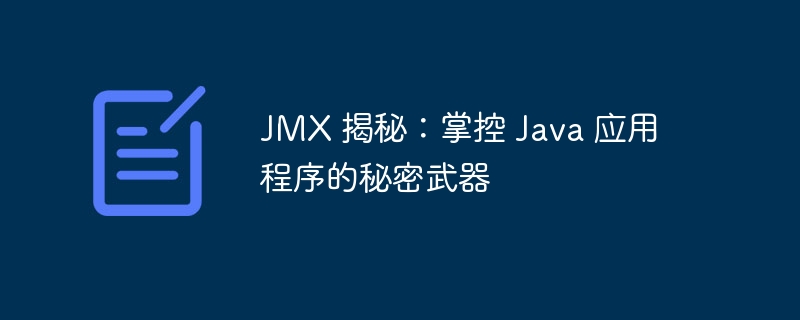Home >Java >javaTutorial >JMX Revealed: The Secret Weapon for Mastering Java Applications
JMX Revealed: The Secret Weapon for Mastering Java Applications
- WBOYWBOYWBOYWBOYWBOYWBOYWBOYWBOYWBOYWBOYWBOYWBOYWBforward
- 2024-02-20 21:33:081125browse

php editor Zimo takes you to reveal JMX, which is the secret weapon for controlling Java applications. JMX (Java Management Extensions) is a standard for monitoring and managing Java applications. It provides a wealth of APIs and tools to help developers monitor application performance, configuration information, logging, etc. Through JMX, developers can monitor the running status of Java applications in real time, discover and solve problems in a timely manner, and improve the stability and performance of applications. Let's delve into the mysteries of JMX and master the skills of Java application management!
JMX Architecture
The core components of JMX include:
- MBean (Management Bean): It represents a manageable component in the application. You can access and manipulate an application's properties, operations, and notifications through MBeans.
- MBean Server: It is a container used to host and manage MBeans. It is responsible for registering, deregistering and calling MBean methods.
- MBean Client: It is an application or tool used to connect to an MBean server and manage MBeans.
Monitor and manage Java applications
JMX provides rich functionality to monitor and manage Java applications:
- Runtime information: You can access information about application status, threads and memory usage.
- Performance Metrics: You can track your application's performance metrics such as throughput, latency, and error rate.
- Configuration changes: You can change the application configuration dynamically without restarting the application.
- Fault Management: You can receive notifications about application failures and take appropriate actions.
Demo code
The following short demo code shows how to use JMX to access an application's runtime information:
import javax.management.JMX;
import javax.management.MBeanServerConnection;
import javax.management.ObjectName;
public class JMXDemo {
public static void main(String[] args) throws Exception {
MBeanServerConnection mbsc = JMX.connect();
ObjectName objectName = new ObjectName("java.lang:type=Runtime");
System.out.println("Uptime: " + mbsc.getAttribute(objectName, "Uptime"));
}
}
Tools and Resources
- JConsole: This is a graphical user interface tool for monitoring and managing Java applications.
- JMX Web Console: This is a WEB based console that allows you to manage applications remotely.
- JMX Instrumentation: This is a library that enables applications to automatically generate MBeans.
Advantage
The advantages of leveraging JMX include:
- Improved Visibility: It provides deep insights into application health and performance.
- Proactive Failure Management: It enables you to identify and resolve problems before they occur.
- Simplified management: It provides a unified interface to manage heterogeneous applications.
- Improve availability: It enables you to dynamically monitor and adjust your application to maximize high availability .
in conclusion
JMX is a powerful tool that can be used to improve the management and monitoring of Java applications. By leveraging its rich functionality, you can proactively monitor application health, troubleshoot issues, and improve performance. Whether you are a developer, system administrator, or end user, JMX provides you with valuable insights and control to help your applications run optimally.
The above is the detailed content of JMX Revealed: The Secret Weapon for Mastering Java Applications. For more information, please follow other related articles on the PHP Chinese website!

